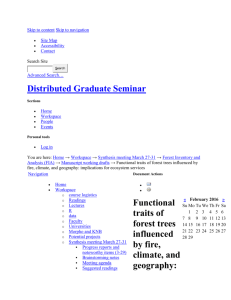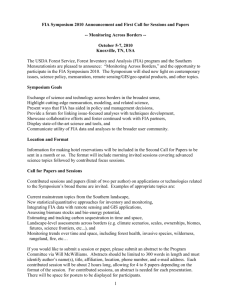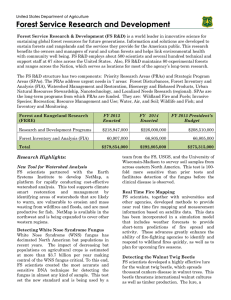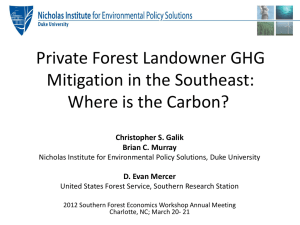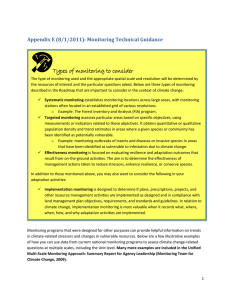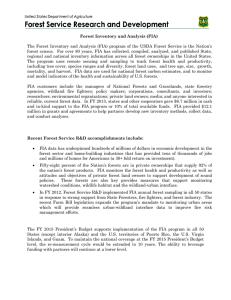EM Proposal…Chojnacky
advertisement
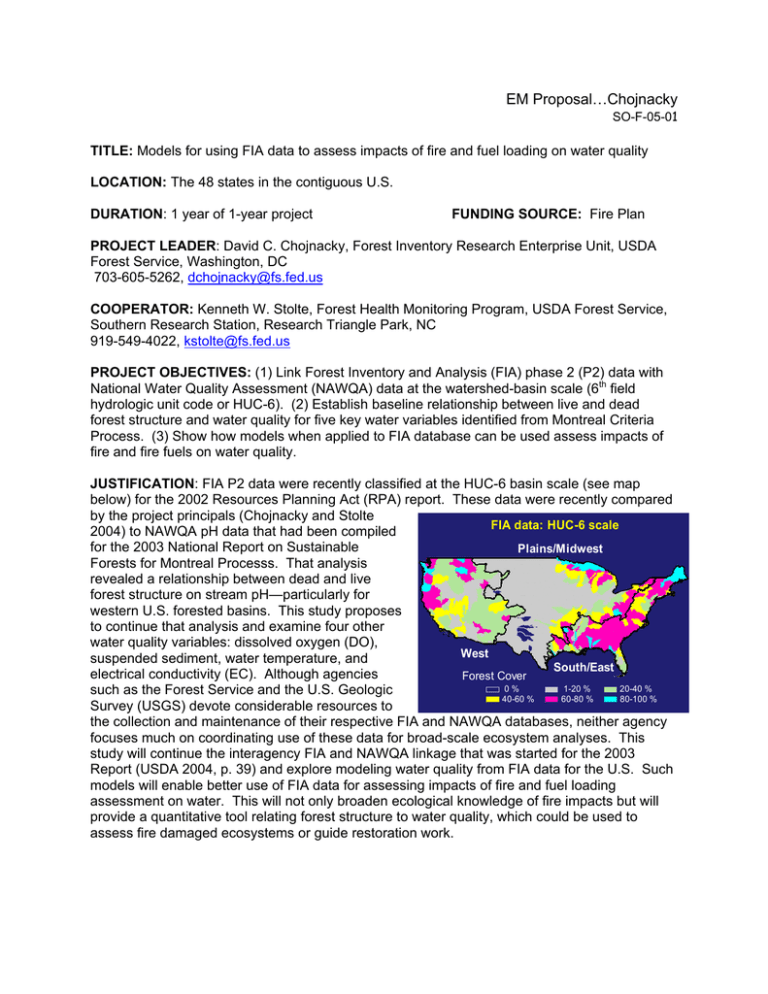
EM Proposal…Chojnacky SO-F-05-01 TITLE: Models for using FIA data to assess impacts of fire and fuel loading on water quality LOCATION: The 48 states in the contiguous U.S. DURATION: 1 year of 1-year project FUNDING SOURCE: Fire Plan PROJECT LEADER: David C. Chojnacky, Forest Inventory Research Enterprise Unit, USDA Forest Service, Washington, DC 703-605-5262, dchojnacky@fs.fed.us COOPERATOR: Kenneth W. Stolte, Forest Health Monitoring Program, USDA Forest Service, Southern Research Station, Research Triangle Park, NC 919-549-4022, kstolte@fs.fed.us PROJECT OBJECTIVES: (1) Link Forest Inventory and Analysis (FIA) phase 2 (P2) data with National Water Quality Assessment (NAWQA) data at the watershed-basin scale (6th field hydrologic unit code or HUC-6). (2) Establish baseline relationship between live and dead forest structure and water quality for five key water variables identified from Montreal Criteria Process. (3) Show how models when applied to FIA database can be used assess impacts of fire and fire fuels on water quality. JUSTIFICATION: FIA P2 data were recently classified at the HUC-6 basin scale (see map below) for the 2002 Resources Planning Act (RPA) report. These data were recently compared by the project principals (Chojnacky and Stolte FIA data: HUC-6 scale 2004) to NAWQA pH data that had been compiled for the 2003 National Report on Sustainable Plains/Midwest Forests for Montreal Processs. That analysis revealed a relationship between dead and live forest structure on stream pH—particularly for western U.S. forested basins. This study proposes to continue that analysis and examine four other water quality variables: dissolved oxygen (DO), West suspended sediment, water temperature, and South/East electrical conductivity (EC). Although agencies Forest Cover 0% 1-20 % 20-40 % such as the Forest Service and the U.S. Geologic 40-60 % 60-80 % 80-100 % Survey (USGS) devote considerable resources to the collection and maintenance of their respective FIA and NAWQA databases, neither agency focuses much on coordinating use of these data for broad-scale ecosystem analyses. This study will continue the interagency FIA and NAWQA linkage that was started for the 2003 Report (USDA 2004, p. 39) and explore modeling water quality from FIA data for the U.S. Such models will enable better use of FIA data for assessing impacts of fire and fuel loading assessment on water. This will not only broaden ecological knowledge of fire impacts but will provide a quantitative tool relating forest structure to water quality, which could be used to assess fire damaged ecosystems or guide restoration work. EM Proposal…Chojnacky SO-F-05-01 DESCRIPTION: a. Background: To advance forest sustainability throughout the U.S., the Montreal Process was used to guide the reporting on 67 criteria and indicators (C&I) (USDA 2004). Indicator 24 from the C&I report, on water quality of forested watersheds, was described with data merged from FIA and NAWQA data (Chojnacky and Stolte pH for Forested HUC-6 Basins 2002, 2003). The proposed study aims to use these data more fully and to model water quality Plains/Midwest from FIA variables. For example, preliminary findings for (1) total biomass per HUC-6 land area and (2) Mg/ha biomass of forest HUC-6 for both live and dead variables were statistically significant and quite explanatory (R2 = 0.50) for predicting stream water pH (see HUC-6 pH map on side) for western water basins. West Although less explanatory models resulted for South/East the rest of the U.S., the significant variables pH nonforest 4.3-6.5 6.5-7.0 showed promise for further study (Chojnacky 7.0-7.5 7.5-8.0 8.0-8.5 and Stolte 2004). In addition to pH, we plan to look at similar model relationships for the rest of the C&I water quality variables and particularly to examine the importance of dead wood as it affects water quality. Our goal is to provide land managers, planners, and policy analysts an effective tool to use FIA data to assess fire risk and effects on water quality. b. Methods: HUC-6 scale water and FIA data have already been obtained, so analysis could begin at once. However, it might be better to do the analysis at the HUC-8 watershed scale, which divides the 333 HUC-6 basins into more than 2,000 watersheds. The finer scale HUC-8 data would give a much larger sample size and likely lead to more precise models having more ecological sensitivity. However, HUC-8 classified FIA data will require a special release of 2002 RPA data, which may or may not be granted. At any rate, analysis will proceed at the HUC-6 scale if HUC-8 data can not be quickly obtained from the FIA program. Data analysis will use regression, nonparametric classification regression trees (CART), and other data mining tools. Objectives will be to develop predictive models and to examine relationships among predictive variables for a better understanding of forest and water qualtiy relationships. Other relevant geographic data on anthropogenic disturbances will also be used. Statistical results will be further analyzed with GIS mapping tools. c. Products: The primary results will be models that estimate water quality variables from FIA data at the HUC-6 scale (or HUC-8, if FIA data can be obtained at that scale). The analysis will provide a 1990s baseline for assessing forest water quality and can be examined to assess effects of recent and future fires as new FIA and NAWQA data are added to respective databases. Continental U.S. maps will be produced for easy interpretation of results. EM Proposal…Chojnacky SO-F-05-01 d. Schedule of Activities: Look into obtaining FIA data at HUC-8 scale Summarize/analyze all data at selected HUC scale (HUC-8 or HUC-6) Model pH, DO, sediment, temperature, and EC as functions of FIA P2 data Produce final models and maps Mar 2005 Apr 2005 Oct 2005 Feb 2006 e. Progress/Accomplishments: Not applicable. f. References: Chojnacky, D.C.; Stolte, K.W. 2002. Combining USGS and FIA data for national water quality assessment of forest lands. Presented at: Joint Meeting of the 4th Annual Forest Inventory and Analysis Symposium and The Southern Mensurationists. New Orleans, LA, November 2002. Chojnacky, D.C.; Stolte, K.W. 2003. USGS/FIA water quality assessment of forest lands. Poster presented at: Northeastern Forest Resources Planners’ Association (NFRPA) annual meeting. Duluth, MN, August 2003. Chojnacky, D.C.; Stolte, K.W. 2004. Forest watershed assessment: linking data from national water quality assessment (NAWQA) and Forest Inventory and Analysis (FIA). Presented at: Monitoring Science and Technology Symposium. Denver, CO, September 2004. U.S. Department of Agriculture. 2004. National report of sustainable forests—2003. FS-766. Washington, DC: U.S. Department of Agriculture, Forest Service, Washington Office. 139 p. COSTS: Item YEAR 2005 Administration Procurements TOTAL Requested FHM EM Funding Salary/Students Overhead Collaboration Travel 26,500 7,000 5,000 2,000 Contracting Equipment Supplies/Misc 3,500 none needed 1,000 45,000 OtherSource Funding* Source
